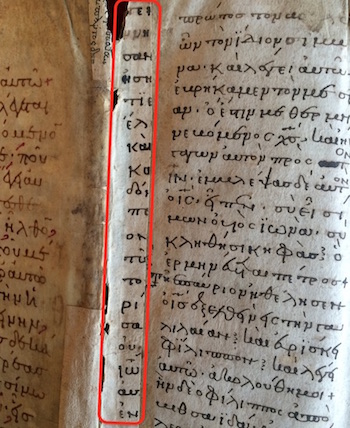The Center for the Study of New Testament Manuscript’s (CSNTM) staff have discovered as many as seventeen New Testament manuscripts at the National Library of Greece in the past 12 months. By ‘discovery’ we mean that, in the least, they have not been officially catalogued yet by the Institute for New Testament Textual Research (INTF) in Muenster, Germany. The INTF is the official cataloging house of all Greek New Testament manuscripts. Generally speaking, if INTF doesn’t know about a manuscript, New Testament scholars don’t know about it either.

Ten of these manuscripts have been internally catalogued by the National Library of Greece. Thus, they know about them and have properly described their contents. But the INTF has no record of them yet. One of CSNTM’s major objectives is to search for uncatalogued manuscripts wherever they go, so that they can digitize them and get the data to Muenster. INTF then goes through a laborious process of checking each manuscript against known manuscripts. Occasionally, they determine that what has been ‘discovered’ is a formerly lost portion of a known manuscript. CSNTM has virtually reunited different portions of manuscripts by working in collaboration with INTF. It is always exciting to discover lost portions of a known manuscript, making it fuller than was previously known.
Many of CSNTM’s discoveries, however, are of manuscripts completely unknown to Muenster and the world of New Testament scholarship. Several of these, as noted, are known to the library that houses the manuscripts, but not to the outside world. But several are discoveries that CSNTM has made—discoveries of manuscripts unknown even to the library in possession of them.
Most of these latter kinds of discoveries fall into one of three groups: (1) Inside-cover leaves used to bind the covers to the manuscript. These consist of one leaf, usually with one side glued to the inside cover and thus unrecoverable. But what can be seen is often older than the known manuscript between the covers. (2) Small reinforcement strips, cut out from other, worn-out manuscripts, that are glued in the margins of pages. (3) Palimpsested leaves—that is, parchment leaves that were reused centuries later by a scribe erasing the text then writing on top of it. The oldest manuscript discovered by CSNTM (from c. the seventh century) is one of these—two leaves at the back of a late medieval manuscript, whose text had been scraped off so that the medieval scribe could reuse them for his own purposes. Five of the New Testament manuscripts discovered this year in Athens fit one of these three categories.
Altogether, the manuscripts discovered this year alone amount to hundreds of pages of text—unique, handwritten copies of the Christian scriptures. Since its inception in 2002, CSNTM staff have discovered more than 90 New Testament manuscripts with more than 20,000 pages of text.
